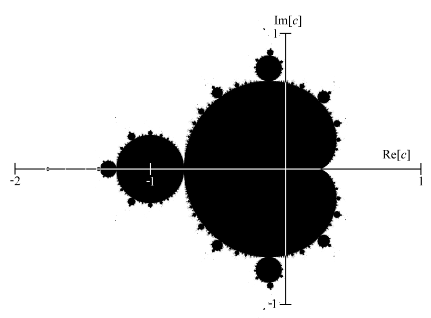nLab Mandelbrot set
Contents
Idea
The Mandelbrot set is the subset of the complex plane on those points on which the iteration of the operation “square and add ” does not diverge.
This is a famous example of a fractal.
Definition
For a complex number, consider the function on the complex plane that squares its argument and adds to the result:
For write
for the -fold composition of with itself ().
Starting with value , this defines a sequence of points in the complex plane for each complex number .
The Mandelbrot set is the subset of the complex plane on those values of for which the corresponding sequence is bounded
Globally, at low resolution, the Mandelbrot set looks like this:

Properties
Topological properties
Definition
(Mandelbrot space)
Regard the Mandelbrot set as a topological space
via the subspace topology inherited from the Euclidean metric topology of .
Proposition
The Mandelbrot space (def. ) is a compact topological space.
We prove this below, after the following lemma:
Lemma
(escape radius)
For then the sequence is not bounded, hence the sequence of absolute values diverges for .
In fact in this case the absolute values increase monotonically:
If then for all we have
Proof
So assume .
We prove the last statement by induction.
Observe that it is true for , where we have
Now assume that there is such that . Then it follows that
Here the first inequality is due to the triangle inequality, the second is due to the induction assumption, and the last one is due to the initial assumption that .
Proof
that the Mandelbrot space is compact (prop. )
By lemma the Mandelbrot set is a bounded subset of 2d Euclidean space. Hence by the Heine-Borel theorem is is now sufficient to show that it is a closed subset, this will imply that it is compact.
The subset is closed if for every point not contained in the Mandelbrot set there is an open neighbourhood of which still does not intersect the Mandelbrot set.
Now that means by definition that for every positive real number there is an such that .
Pick such an for . Let then
and consider the subset
This is clearly an open neighbourhood of . Hence by continuity of the function , the pre-image
is an open neighbourhood of , and by lemma this does not intersect the Mandelbrot set.
Related concepts
Last revised on May 16, 2017 at 17:58:08. See the history of this page for a list of all contributions to it.